Strategic Management: Coursework on Corporate Strategy and Analysis
VerifiedAdded on 2020/01/07
|16
|5947
|596
Homework Assignment
AI Summary
This assignment delves into the core principles of strategic management, exploring various facets crucial for organizational success. It begins by emphasizing the importance of strategic management and how it evolves within a corporation, including the role of learning organizations and the distinction between strategic and other decisions. The assignment explores the role of the board of directors, the influence of environmental factors, and the analysis of competitive intensity within industries, including Porter's discussion. It also examines the resource-based view of the firm, value-chain analysis, and the impact of corporate structure and culture. The assignment further discusses competitive strategies, including cost leadership, differentiation, and first-mover advantages, as well as growth strategies, functional strategies, and organizational structures. It also explores the implementation of strategies, including managing business units, implementing retrenchment, and changing corporate culture. Finally, the assignment addresses evaluation and control processes, including behavior, output, and input controls, and the use of tools like EVA.
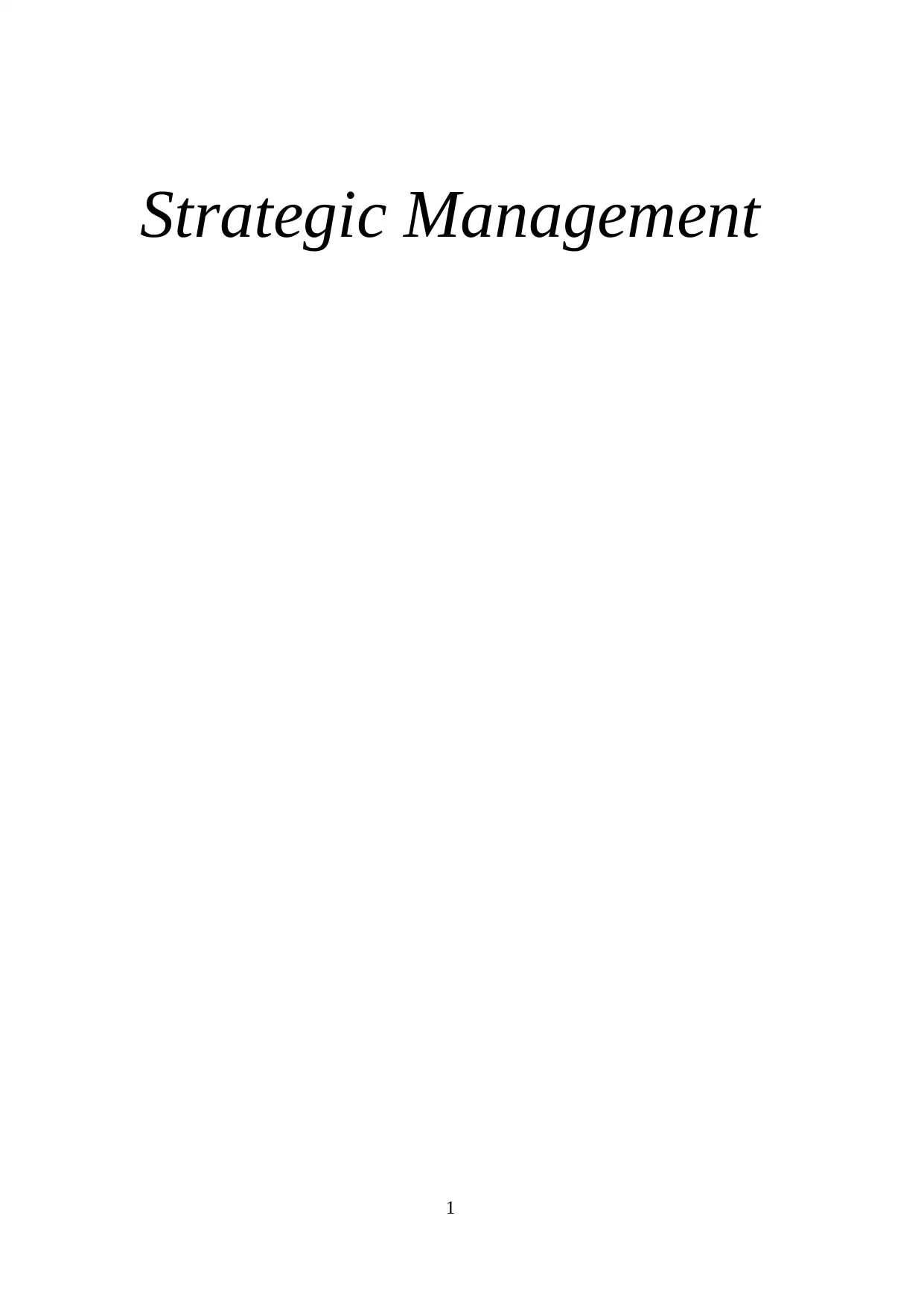
Strategic Management
1
1
Paraphrase This Document
Need a fresh take? Get an instant paraphrase of this document with our AI Paraphraser
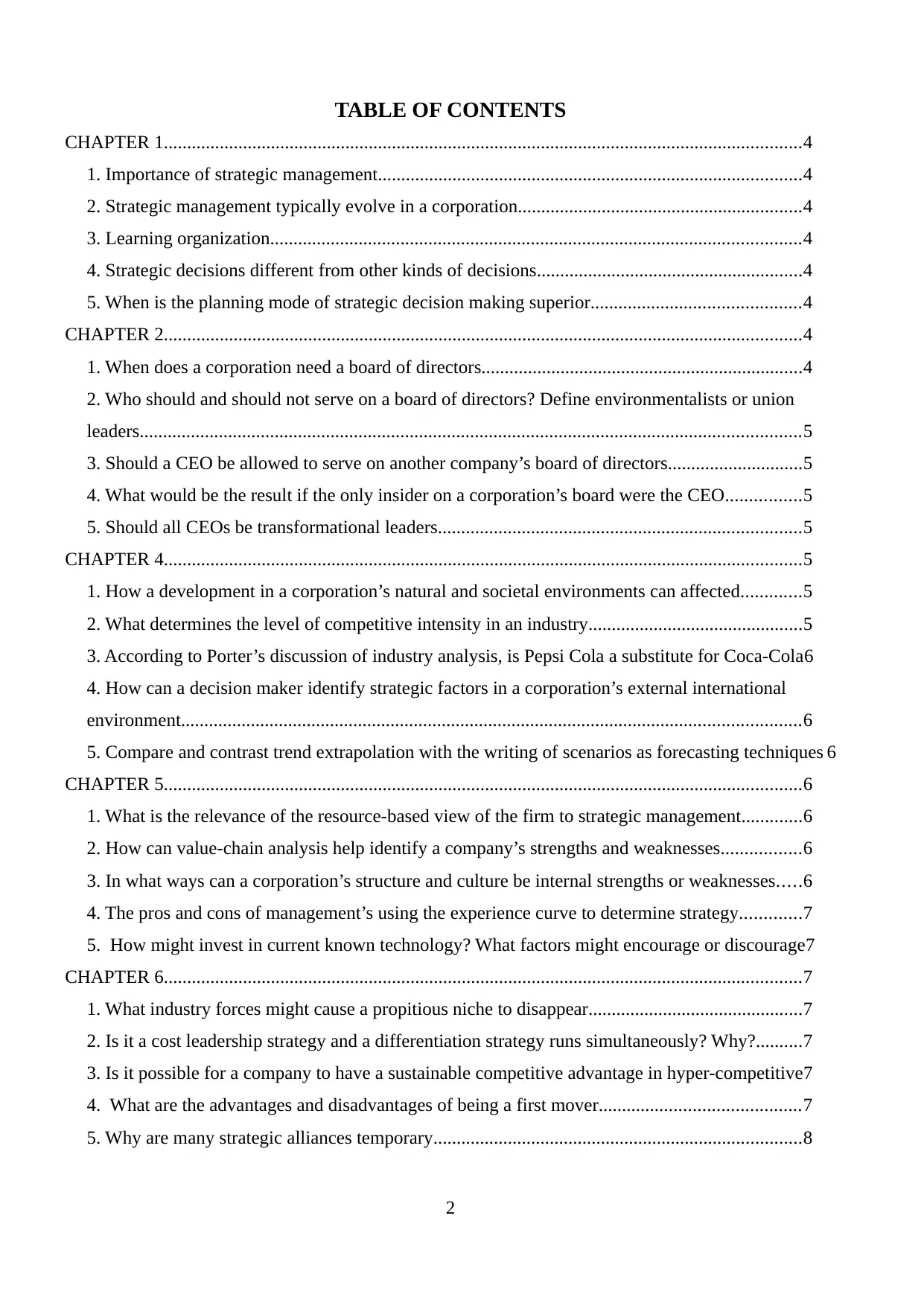
TABLE OF CONTENTS
CHAPTER 1.........................................................................................................................................4
1. Importance of strategic management...........................................................................................4
2. Strategic management typically evolve in a corporation.............................................................4
3. Learning organization..................................................................................................................4
4. Strategic decisions different from other kinds of decisions.........................................................4
5. When is the planning mode of strategic decision making superior.............................................4
CHAPTER 2.........................................................................................................................................4
1. When does a corporation need a board of directors.....................................................................4
2. Who should and should not serve on a board of directors? Define environmentalists or union
leaders..............................................................................................................................................5
3. Should a CEO be allowed to serve on another company’s board of directors.............................5
4. What would be the result if the only insider on a corporation’s board were the CEO................5
5. Should all CEOs be transformational leaders..............................................................................5
CHAPTER 4.........................................................................................................................................5
1. How a development in a corporation’s natural and societal environments can affected.............5
2. What determines the level of competitive intensity in an industry..............................................5
3. According to Porter’s discussion of industry analysis, is Pepsi Cola a substitute for Coca-Cola6
4. How can a decision maker identify strategic factors in a corporation’s external international
environment.....................................................................................................................................6
5. Compare and contrast trend extrapolation with the writing of scenarios as forecasting techniques 6
CHAPTER 5.........................................................................................................................................6
1. What is the relevance of the resource-based view of the firm to strategic management.............6
2. How can value-chain analysis help identify a company’s strengths and weaknesses.................6
3. In what ways can a corporation’s structure and culture be internal strengths or weaknesses.....6
4. The pros and cons of management’s using the experience curve to determine strategy.............7
5. How might invest in current known technology? What factors might encourage or discourage7
CHAPTER 6.........................................................................................................................................7
1. What industry forces might cause a propitious niche to disappear..............................................7
2. Is it a cost leadership strategy and a differentiation strategy runs simultaneously? Why?..........7
3. Is it possible for a company to have a sustainable competitive advantage in hyper-competitive7
4. What are the advantages and disadvantages of being a first mover...........................................7
5. Why are many strategic alliances temporary...............................................................................8
2
CHAPTER 1.........................................................................................................................................4
1. Importance of strategic management...........................................................................................4
2. Strategic management typically evolve in a corporation.............................................................4
3. Learning organization..................................................................................................................4
4. Strategic decisions different from other kinds of decisions.........................................................4
5. When is the planning mode of strategic decision making superior.............................................4
CHAPTER 2.........................................................................................................................................4
1. When does a corporation need a board of directors.....................................................................4
2. Who should and should not serve on a board of directors? Define environmentalists or union
leaders..............................................................................................................................................5
3. Should a CEO be allowed to serve on another company’s board of directors.............................5
4. What would be the result if the only insider on a corporation’s board were the CEO................5
5. Should all CEOs be transformational leaders..............................................................................5
CHAPTER 4.........................................................................................................................................5
1. How a development in a corporation’s natural and societal environments can affected.............5
2. What determines the level of competitive intensity in an industry..............................................5
3. According to Porter’s discussion of industry analysis, is Pepsi Cola a substitute for Coca-Cola6
4. How can a decision maker identify strategic factors in a corporation’s external international
environment.....................................................................................................................................6
5. Compare and contrast trend extrapolation with the writing of scenarios as forecasting techniques 6
CHAPTER 5.........................................................................................................................................6
1. What is the relevance of the resource-based view of the firm to strategic management.............6
2. How can value-chain analysis help identify a company’s strengths and weaknesses.................6
3. In what ways can a corporation’s structure and culture be internal strengths or weaknesses.....6
4. The pros and cons of management’s using the experience curve to determine strategy.............7
5. How might invest in current known technology? What factors might encourage or discourage7
CHAPTER 6.........................................................................................................................................7
1. What industry forces might cause a propitious niche to disappear..............................................7
2. Is it a cost leadership strategy and a differentiation strategy runs simultaneously? Why?..........7
3. Is it possible for a company to have a sustainable competitive advantage in hyper-competitive7
4. What are the advantages and disadvantages of being a first mover...........................................7
5. Why are many strategic alliances temporary...............................................................................8
2
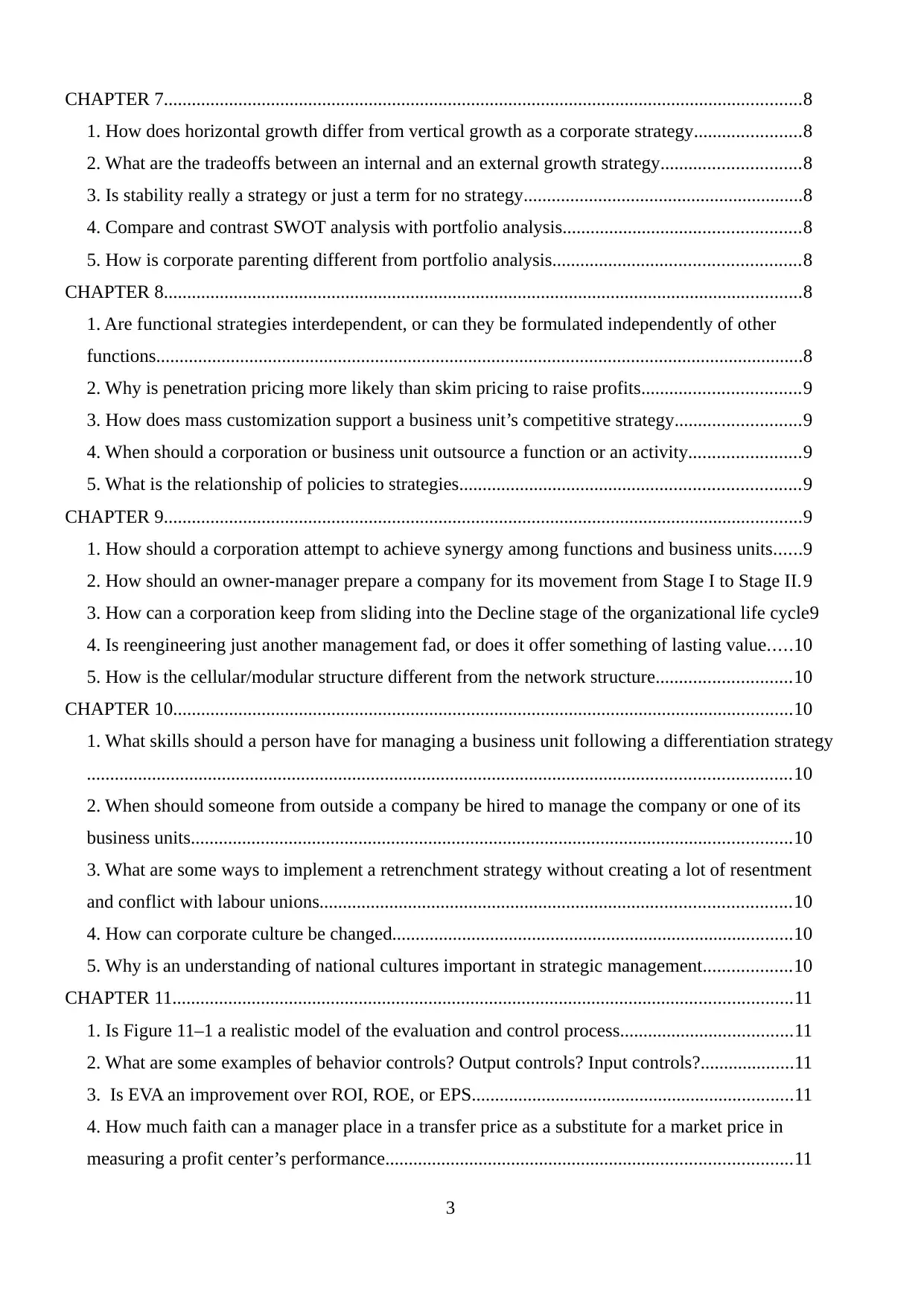
CHAPTER 7.........................................................................................................................................8
1. How does horizontal growth differ from vertical growth as a corporate strategy.......................8
2. What are the tradeoffs between an internal and an external growth strategy..............................8
3. Is stability really a strategy or just a term for no strategy............................................................8
4. Compare and contrast SWOT analysis with portfolio analysis...................................................8
5. How is corporate parenting different from portfolio analysis.....................................................8
CHAPTER 8.........................................................................................................................................8
1. Are functional strategies interdependent, or can they be formulated independently of other
functions...........................................................................................................................................8
2. Why is penetration pricing more likely than skim pricing to raise profits..................................9
3. How does mass customization support a business unit’s competitive strategy...........................9
4. When should a corporation or business unit outsource a function or an activity........................9
5. What is the relationship of policies to strategies.........................................................................9
CHAPTER 9.........................................................................................................................................9
1. How should a corporation attempt to achieve synergy among functions and business units......9
2. How should an owner-manager prepare a company for its movement from Stage I to Stage II.9
3. How can a corporation keep from sliding into the Decline stage of the organizational life cycle9
4. Is reengineering just another management fad, or does it offer something of lasting value.....10
5. How is the cellular/modular structure different from the network structure.............................10
CHAPTER 10.....................................................................................................................................10
1. What skills should a person have for managing a business unit following a differentiation strategy
.......................................................................................................................................................10
2. When should someone from outside a company be hired to manage the company or one of its
business units.................................................................................................................................10
3. What are some ways to implement a retrenchment strategy without creating a lot of resentment
and conflict with labour unions.....................................................................................................10
4. How can corporate culture be changed......................................................................................10
5. Why is an understanding of national cultures important in strategic management...................10
CHAPTER 11.....................................................................................................................................11
1. Is Figure 11–1 a realistic model of the evaluation and control process.....................................11
2. What are some examples of behavior controls? Output controls? Input controls?....................11
3. Is EVA an improvement over ROI, ROE, or EPS.....................................................................11
4. How much faith can a manager place in a transfer price as a substitute for a market price in
measuring a profit center’s performance.......................................................................................11
3
1. How does horizontal growth differ from vertical growth as a corporate strategy.......................8
2. What are the tradeoffs between an internal and an external growth strategy..............................8
3. Is stability really a strategy or just a term for no strategy............................................................8
4. Compare and contrast SWOT analysis with portfolio analysis...................................................8
5. How is corporate parenting different from portfolio analysis.....................................................8
CHAPTER 8.........................................................................................................................................8
1. Are functional strategies interdependent, or can they be formulated independently of other
functions...........................................................................................................................................8
2. Why is penetration pricing more likely than skim pricing to raise profits..................................9
3. How does mass customization support a business unit’s competitive strategy...........................9
4. When should a corporation or business unit outsource a function or an activity........................9
5. What is the relationship of policies to strategies.........................................................................9
CHAPTER 9.........................................................................................................................................9
1. How should a corporation attempt to achieve synergy among functions and business units......9
2. How should an owner-manager prepare a company for its movement from Stage I to Stage II.9
3. How can a corporation keep from sliding into the Decline stage of the organizational life cycle9
4. Is reengineering just another management fad, or does it offer something of lasting value.....10
5. How is the cellular/modular structure different from the network structure.............................10
CHAPTER 10.....................................................................................................................................10
1. What skills should a person have for managing a business unit following a differentiation strategy
.......................................................................................................................................................10
2. When should someone from outside a company be hired to manage the company or one of its
business units.................................................................................................................................10
3. What are some ways to implement a retrenchment strategy without creating a lot of resentment
and conflict with labour unions.....................................................................................................10
4. How can corporate culture be changed......................................................................................10
5. Why is an understanding of national cultures important in strategic management...................10
CHAPTER 11.....................................................................................................................................11
1. Is Figure 11–1 a realistic model of the evaluation and control process.....................................11
2. What are some examples of behavior controls? Output controls? Input controls?....................11
3. Is EVA an improvement over ROI, ROE, or EPS.....................................................................11
4. How much faith can a manager place in a transfer price as a substitute for a market price in
measuring a profit center’s performance.......................................................................................11
3
⊘ This is a preview!⊘
Do you want full access?
Subscribe today to unlock all pages.

Trusted by 1+ million students worldwide
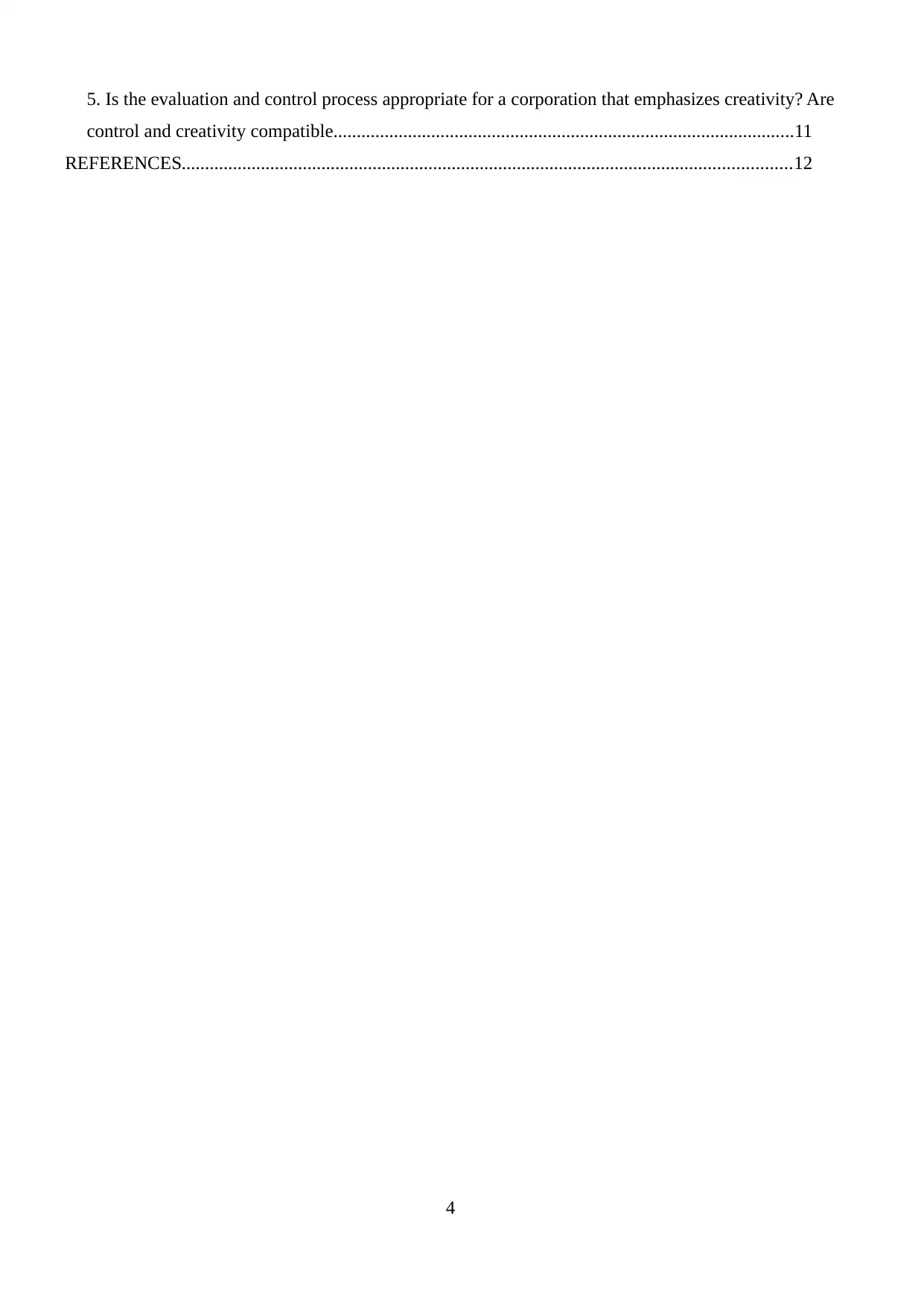
5. Is the evaluation and control process appropriate for a corporation that emphasizes creativity? Are
control and creativity compatible...................................................................................................11
REFERENCES...................................................................................................................................12
4
control and creativity compatible...................................................................................................11
REFERENCES...................................................................................................................................12
4
Paraphrase This Document
Need a fresh take? Get an instant paraphrase of this document with our AI Paraphraser
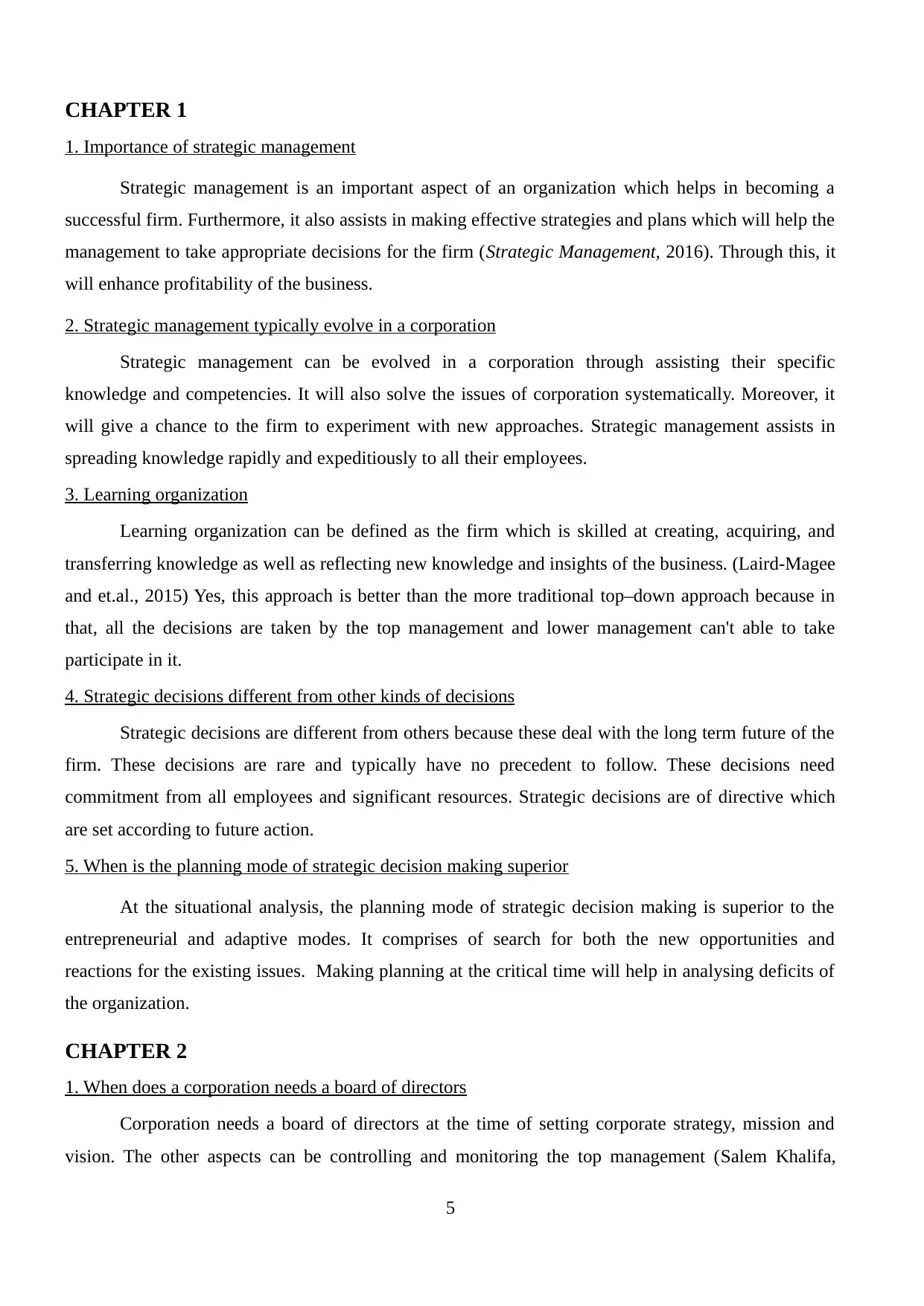
CHAPTER 1
1. Importance of strategic management
Strategic management is an important aspect of an organization which helps in becoming a
successful firm. Furthermore, it also assists in making effective strategies and plans which will help the
management to take appropriate decisions for the firm (Strategic Management, 2016). Through this, it
will enhance profitability of the business.
2. Strategic management typically evolve in a corporation
Strategic management can be evolved in a corporation through assisting their specific
knowledge and competencies. It will also solve the issues of corporation systematically. Moreover, it
will give a chance to the firm to experiment with new approaches. Strategic management assists in
spreading knowledge rapidly and expeditiously to all their employees.
3. Learning organization
Learning organization can be defined as the firm which is skilled at creating, acquiring, and
transferring knowledge as well as reflecting new knowledge and insights of the business. (Laird-Magee
and et.al., 2015) Yes, this approach is better than the more traditional top–down approach because in
that, all the decisions are taken by the top management and lower management can't able to take
participate in it.
4. Strategic decisions different from other kinds of decisions
Strategic decisions are different from others because these deal with the long term future of the
firm. These decisions are rare and typically have no precedent to follow. These decisions need
commitment from all employees and significant resources. Strategic decisions are of directive which
are set according to future action.
5. When is the planning mode of strategic decision making superior
At the situational analysis, the planning mode of strategic decision making is superior to the
entrepreneurial and adaptive modes. It comprises of search for both the new opportunities and
reactions for the existing issues. Making planning at the critical time will help in analysing deficits of
the organization.
CHAPTER 2
1. When does a corporation needs a board of directors
Corporation needs a board of directors at the time of setting corporate strategy, mission and
vision. The other aspects can be controlling and monitoring the top management (Salem Khalifa,
5
1. Importance of strategic management
Strategic management is an important aspect of an organization which helps in becoming a
successful firm. Furthermore, it also assists in making effective strategies and plans which will help the
management to take appropriate decisions for the firm (Strategic Management, 2016). Through this, it
will enhance profitability of the business.
2. Strategic management typically evolve in a corporation
Strategic management can be evolved in a corporation through assisting their specific
knowledge and competencies. It will also solve the issues of corporation systematically. Moreover, it
will give a chance to the firm to experiment with new approaches. Strategic management assists in
spreading knowledge rapidly and expeditiously to all their employees.
3. Learning organization
Learning organization can be defined as the firm which is skilled at creating, acquiring, and
transferring knowledge as well as reflecting new knowledge and insights of the business. (Laird-Magee
and et.al., 2015) Yes, this approach is better than the more traditional top–down approach because in
that, all the decisions are taken by the top management and lower management can't able to take
participate in it.
4. Strategic decisions different from other kinds of decisions
Strategic decisions are different from others because these deal with the long term future of the
firm. These decisions are rare and typically have no precedent to follow. These decisions need
commitment from all employees and significant resources. Strategic decisions are of directive which
are set according to future action.
5. When is the planning mode of strategic decision making superior
At the situational analysis, the planning mode of strategic decision making is superior to the
entrepreneurial and adaptive modes. It comprises of search for both the new opportunities and
reactions for the existing issues. Making planning at the critical time will help in analysing deficits of
the organization.
CHAPTER 2
1. When does a corporation needs a board of directors
Corporation needs a board of directors at the time of setting corporate strategy, mission and
vision. The other aspects can be controlling and monitoring the top management (Salem Khalifa,
5
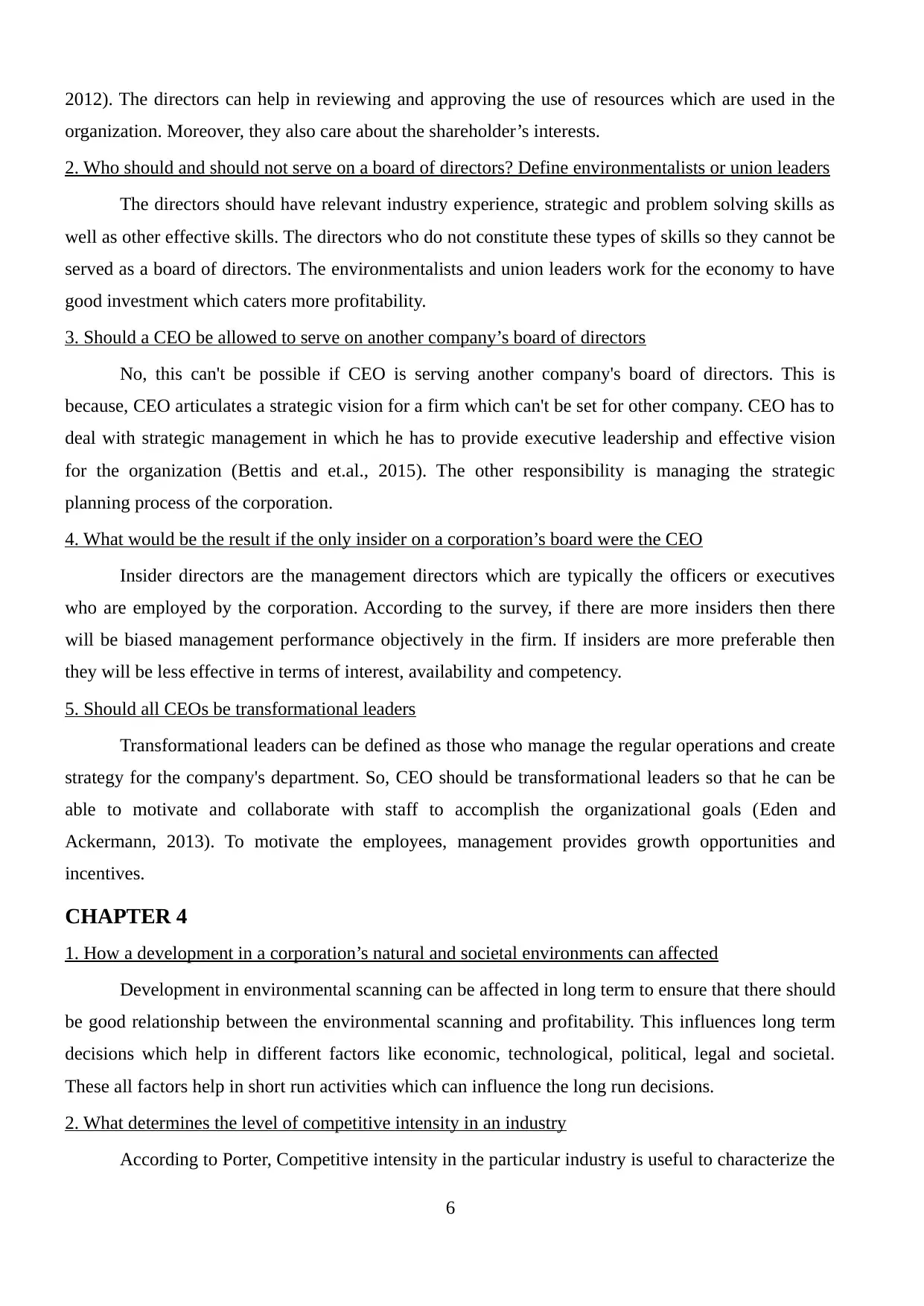
2012). The directors can help in reviewing and approving the use of resources which are used in the
organization. Moreover, they also care about the shareholder’s interests.
2. Who should and should not serve on a board of directors? Define environmentalists or union leaders
The directors should have relevant industry experience, strategic and problem solving skills as
well as other effective skills. The directors who do not constitute these types of skills so they cannot be
served as a board of directors. The environmentalists and union leaders work for the economy to have
good investment which caters more profitability.
3. Should a CEO be allowed to serve on another company’s board of directors
No, this can't be possible if CEO is serving another company's board of directors. This is
because, CEO articulates a strategic vision for a firm which can't be set for other company. CEO has to
deal with strategic management in which he has to provide executive leadership and effective vision
for the organization (Bettis and et.al., 2015). The other responsibility is managing the strategic
planning process of the corporation.
4. What would be the result if the only insider on a corporation’s board were the CEO
Insider directors are the management directors which are typically the officers or executives
who are employed by the corporation. According to the survey, if there are more insiders then there
will be biased management performance objectively in the firm. If insiders are more preferable then
they will be less effective in terms of interest, availability and competency.
5. Should all CEOs be transformational leaders
Transformational leaders can be defined as those who manage the regular operations and create
strategy for the company's department. So, CEO should be transformational leaders so that he can be
able to motivate and collaborate with staff to accomplish the organizational goals (Eden and
Ackermann, 2013). To motivate the employees, management provides growth opportunities and
incentives.
CHAPTER 4
1. How a development in a corporation’s natural and societal environments can affected
Development in environmental scanning can be affected in long term to ensure that there should
be good relationship between the environmental scanning and profitability. This influences long term
decisions which help in different factors like economic, technological, political, legal and societal.
These all factors help in short run activities which can influence the long run decisions.
2. What determines the level of competitive intensity in an industry
According to Porter, Competitive intensity in the particular industry is useful to characterize the
6
organization. Moreover, they also care about the shareholder’s interests.
2. Who should and should not serve on a board of directors? Define environmentalists or union leaders
The directors should have relevant industry experience, strategic and problem solving skills as
well as other effective skills. The directors who do not constitute these types of skills so they cannot be
served as a board of directors. The environmentalists and union leaders work for the economy to have
good investment which caters more profitability.
3. Should a CEO be allowed to serve on another company’s board of directors
No, this can't be possible if CEO is serving another company's board of directors. This is
because, CEO articulates a strategic vision for a firm which can't be set for other company. CEO has to
deal with strategic management in which he has to provide executive leadership and effective vision
for the organization (Bettis and et.al., 2015). The other responsibility is managing the strategic
planning process of the corporation.
4. What would be the result if the only insider on a corporation’s board were the CEO
Insider directors are the management directors which are typically the officers or executives
who are employed by the corporation. According to the survey, if there are more insiders then there
will be biased management performance objectively in the firm. If insiders are more preferable then
they will be less effective in terms of interest, availability and competency.
5. Should all CEOs be transformational leaders
Transformational leaders can be defined as those who manage the regular operations and create
strategy for the company's department. So, CEO should be transformational leaders so that he can be
able to motivate and collaborate with staff to accomplish the organizational goals (Eden and
Ackermann, 2013). To motivate the employees, management provides growth opportunities and
incentives.
CHAPTER 4
1. How a development in a corporation’s natural and societal environments can affected
Development in environmental scanning can be affected in long term to ensure that there should
be good relationship between the environmental scanning and profitability. This influences long term
decisions which help in different factors like economic, technological, political, legal and societal.
These all factors help in short run activities which can influence the long run decisions.
2. What determines the level of competitive intensity in an industry
According to Porter, Competitive intensity in the particular industry is useful to characterize the
6
⊘ This is a preview!⊘
Do you want full access?
Subscribe today to unlock all pages.

Trusted by 1+ million students worldwide
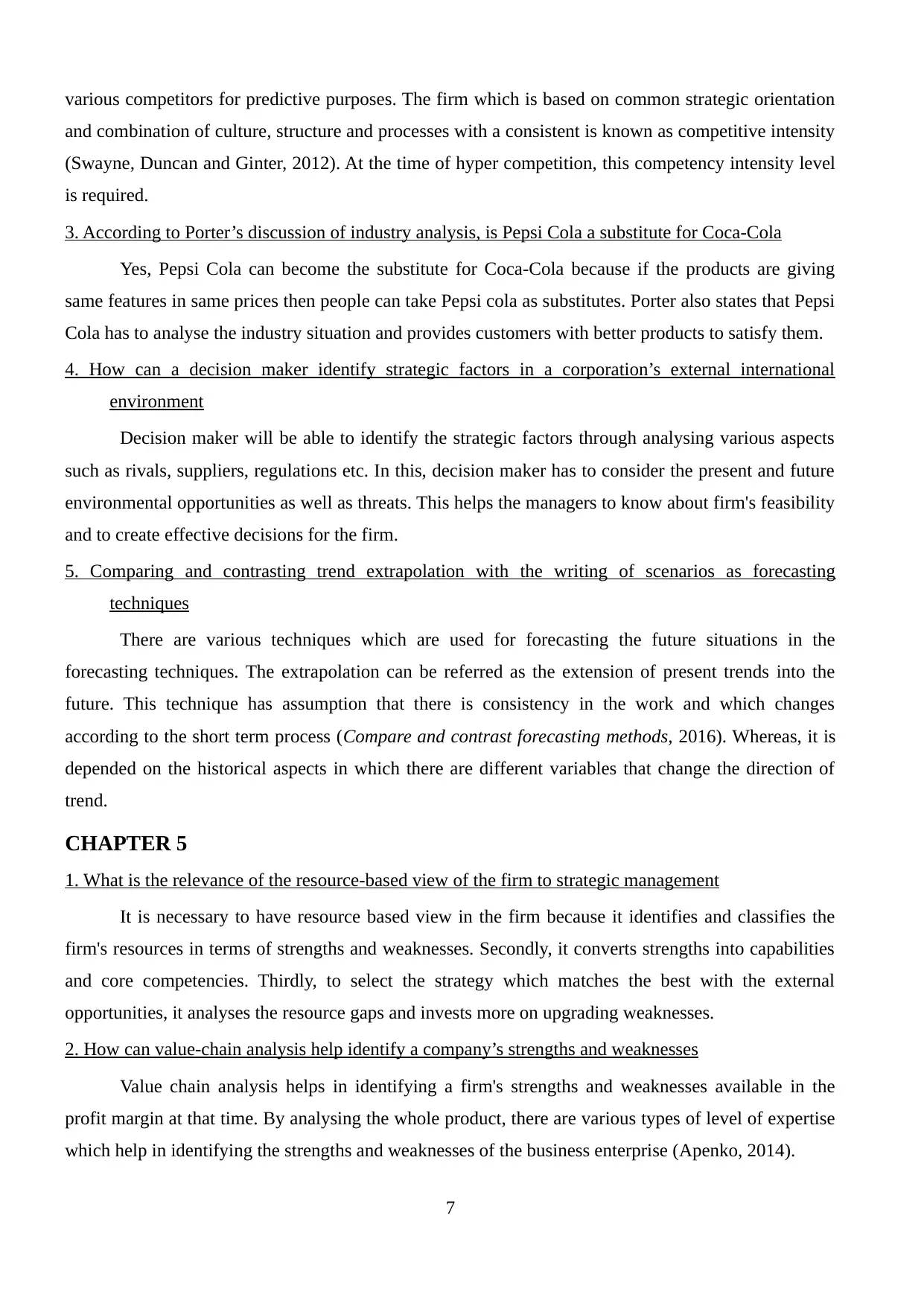
various competitors for predictive purposes. The firm which is based on common strategic orientation
and combination of culture, structure and processes with a consistent is known as competitive intensity
(Swayne, Duncan and Ginter, 2012). At the time of hyper competition, this competency intensity level
is required.
3. According to Porter’s discussion of industry analysis, is Pepsi Cola a substitute for Coca-Cola
Yes, Pepsi Cola can become the substitute for Coca-Cola because if the products are giving
same features in same prices then people can take Pepsi cola as substitutes. Porter also states that Pepsi
Cola has to analyse the industry situation and provides customers with better products to satisfy them.
4. How can a decision maker identify strategic factors in a corporation’s external international
environment
Decision maker will be able to identify the strategic factors through analysing various aspects
such as rivals, suppliers, regulations etc. In this, decision maker has to consider the present and future
environmental opportunities as well as threats. This helps the managers to know about firm's feasibility
and to create effective decisions for the firm.
5. Comparing and contrasting trend extrapolation with the writing of scenarios as forecasting
techniques
There are various techniques which are used for forecasting the future situations in the
forecasting techniques. The extrapolation can be referred as the extension of present trends into the
future. This technique has assumption that there is consistency in the work and which changes
according to the short term process (Compare and contrast forecasting methods, 2016). Whereas, it is
depended on the historical aspects in which there are different variables that change the direction of
trend.
CHAPTER 5
1. What is the relevance of the resource-based view of the firm to strategic management
It is necessary to have resource based view in the firm because it identifies and classifies the
firm's resources in terms of strengths and weaknesses. Secondly, it converts strengths into capabilities
and core competencies. Thirdly, to select the strategy which matches the best with the external
opportunities, it analyses the resource gaps and invests more on upgrading weaknesses.
2. How can value-chain analysis help identify a company’s strengths and weaknesses
Value chain analysis helps in identifying a firm's strengths and weaknesses available in the
profit margin at that time. By analysing the whole product, there are various types of level of expertise
which help in identifying the strengths and weaknesses of the business enterprise (Apenko, 2014).
7
and combination of culture, structure and processes with a consistent is known as competitive intensity
(Swayne, Duncan and Ginter, 2012). At the time of hyper competition, this competency intensity level
is required.
3. According to Porter’s discussion of industry analysis, is Pepsi Cola a substitute for Coca-Cola
Yes, Pepsi Cola can become the substitute for Coca-Cola because if the products are giving
same features in same prices then people can take Pepsi cola as substitutes. Porter also states that Pepsi
Cola has to analyse the industry situation and provides customers with better products to satisfy them.
4. How can a decision maker identify strategic factors in a corporation’s external international
environment
Decision maker will be able to identify the strategic factors through analysing various aspects
such as rivals, suppliers, regulations etc. In this, decision maker has to consider the present and future
environmental opportunities as well as threats. This helps the managers to know about firm's feasibility
and to create effective decisions for the firm.
5. Comparing and contrasting trend extrapolation with the writing of scenarios as forecasting
techniques
There are various techniques which are used for forecasting the future situations in the
forecasting techniques. The extrapolation can be referred as the extension of present trends into the
future. This technique has assumption that there is consistency in the work and which changes
according to the short term process (Compare and contrast forecasting methods, 2016). Whereas, it is
depended on the historical aspects in which there are different variables that change the direction of
trend.
CHAPTER 5
1. What is the relevance of the resource-based view of the firm to strategic management
It is necessary to have resource based view in the firm because it identifies and classifies the
firm's resources in terms of strengths and weaknesses. Secondly, it converts strengths into capabilities
and core competencies. Thirdly, to select the strategy which matches the best with the external
opportunities, it analyses the resource gaps and invests more on upgrading weaknesses.
2. How can value-chain analysis help identify a company’s strengths and weaknesses
Value chain analysis helps in identifying a firm's strengths and weaknesses available in the
profit margin at that time. By analysing the whole product, there are various types of level of expertise
which help in identifying the strengths and weaknesses of the business enterprise (Apenko, 2014).
7
Paraphrase This Document
Need a fresh take? Get an instant paraphrase of this document with our AI Paraphraser
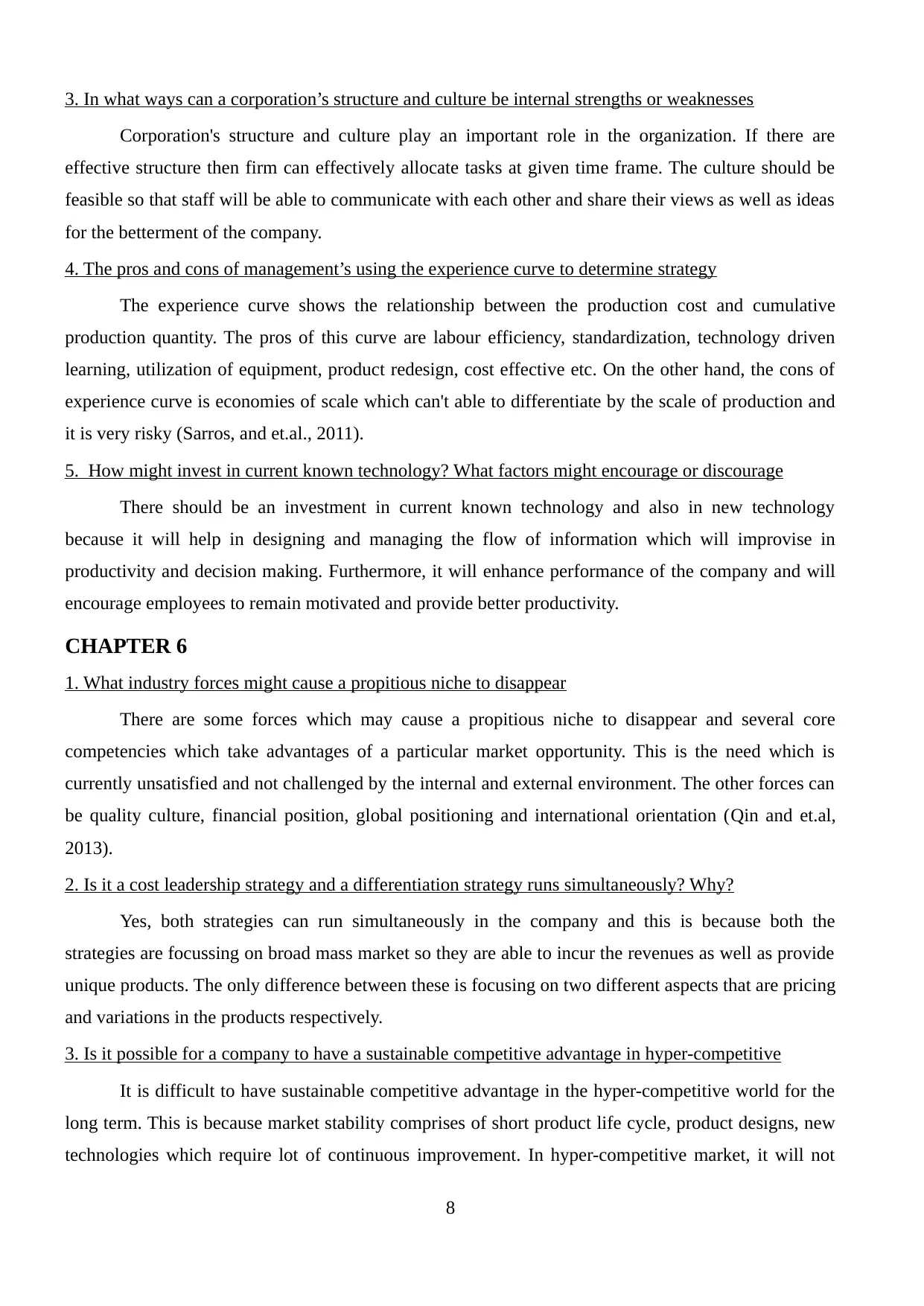
3. In what ways can a corporation’s structure and culture be internal strengths or weaknesses
Corporation's structure and culture play an important role in the organization. If there are
effective structure then firm can effectively allocate tasks at given time frame. The culture should be
feasible so that staff will be able to communicate with each other and share their views as well as ideas
for the betterment of the company.
4. The pros and cons of management’s using the experience curve to determine strategy
The experience curve shows the relationship between the production cost and cumulative
production quantity. The pros of this curve are labour efficiency, standardization, technology driven
learning, utilization of equipment, product redesign, cost effective etc. On the other hand, the cons of
experience curve is economies of scale which can't able to differentiate by the scale of production and
it is very risky (Sarros, and et.al., 2011).
5. How might invest in current known technology? What factors might encourage or discourage
There should be an investment in current known technology and also in new technology
because it will help in designing and managing the flow of information which will improvise in
productivity and decision making. Furthermore, it will enhance performance of the company and will
encourage employees to remain motivated and provide better productivity.
CHAPTER 6
1. What industry forces might cause a propitious niche to disappear
There are some forces which may cause a propitious niche to disappear and several core
competencies which take advantages of a particular market opportunity. This is the need which is
currently unsatisfied and not challenged by the internal and external environment. The other forces can
be quality culture, financial position, global positioning and international orientation (Qin and et.al,
2013).
2. Is it a cost leadership strategy and a differentiation strategy runs simultaneously? Why?
Yes, both strategies can run simultaneously in the company and this is because both the
strategies are focussing on broad mass market so they are able to incur the revenues as well as provide
unique products. The only difference between these is focusing on two different aspects that are pricing
and variations in the products respectively.
3. Is it possible for a company to have a sustainable competitive advantage in hyper-competitive
It is difficult to have sustainable competitive advantage in the hyper-competitive world for the
long term. This is because market stability comprises of short product life cycle, product designs, new
technologies which require lot of continuous improvement. In hyper-competitive market, it will not
8
Corporation's structure and culture play an important role in the organization. If there are
effective structure then firm can effectively allocate tasks at given time frame. The culture should be
feasible so that staff will be able to communicate with each other and share their views as well as ideas
for the betterment of the company.
4. The pros and cons of management’s using the experience curve to determine strategy
The experience curve shows the relationship between the production cost and cumulative
production quantity. The pros of this curve are labour efficiency, standardization, technology driven
learning, utilization of equipment, product redesign, cost effective etc. On the other hand, the cons of
experience curve is economies of scale which can't able to differentiate by the scale of production and
it is very risky (Sarros, and et.al., 2011).
5. How might invest in current known technology? What factors might encourage or discourage
There should be an investment in current known technology and also in new technology
because it will help in designing and managing the flow of information which will improvise in
productivity and decision making. Furthermore, it will enhance performance of the company and will
encourage employees to remain motivated and provide better productivity.
CHAPTER 6
1. What industry forces might cause a propitious niche to disappear
There are some forces which may cause a propitious niche to disappear and several core
competencies which take advantages of a particular market opportunity. This is the need which is
currently unsatisfied and not challenged by the internal and external environment. The other forces can
be quality culture, financial position, global positioning and international orientation (Qin and et.al,
2013).
2. Is it a cost leadership strategy and a differentiation strategy runs simultaneously? Why?
Yes, both strategies can run simultaneously in the company and this is because both the
strategies are focussing on broad mass market so they are able to incur the revenues as well as provide
unique products. The only difference between these is focusing on two different aspects that are pricing
and variations in the products respectively.
3. Is it possible for a company to have a sustainable competitive advantage in hyper-competitive
It is difficult to have sustainable competitive advantage in the hyper-competitive world for the
long term. This is because market stability comprises of short product life cycle, product designs, new
technologies which require lot of continuous improvement. In hyper-competitive market, it will not
8
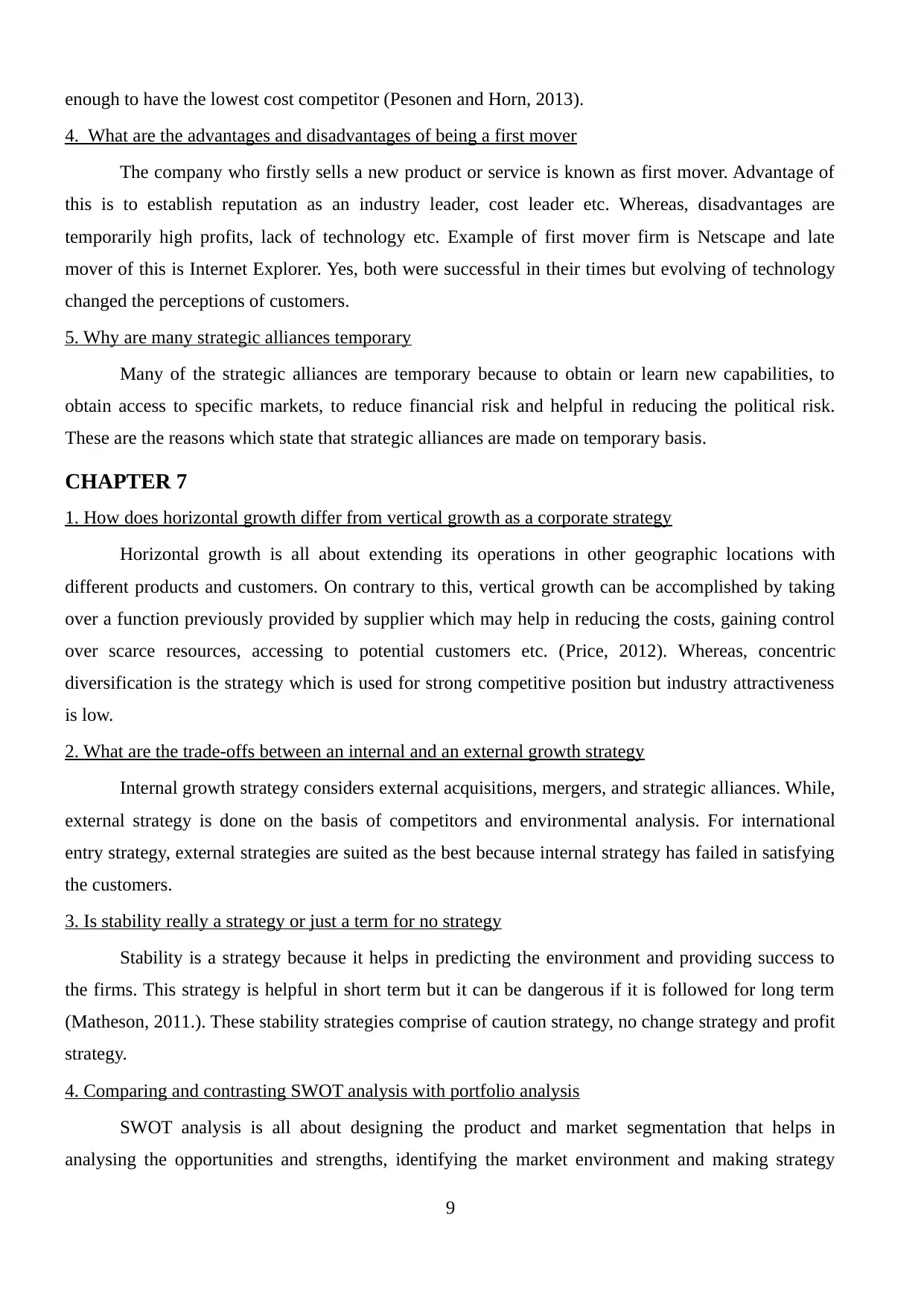
enough to have the lowest cost competitor (Pesonen and Horn, 2013).
4. What are the advantages and disadvantages of being a first mover
The company who firstly sells a new product or service is known as first mover. Advantage of
this is to establish reputation as an industry leader, cost leader etc. Whereas, disadvantages are
temporarily high profits, lack of technology etc. Example of first mover firm is Netscape and late
mover of this is Internet Explorer. Yes, both were successful in their times but evolving of technology
changed the perceptions of customers.
5. Why are many strategic alliances temporary
Many of the strategic alliances are temporary because to obtain or learn new capabilities, to
obtain access to specific markets, to reduce financial risk and helpful in reducing the political risk.
These are the reasons which state that strategic alliances are made on temporary basis.
CHAPTER 7
1. How does horizontal growth differ from vertical growth as a corporate strategy
Horizontal growth is all about extending its operations in other geographic locations with
different products and customers. On contrary to this, vertical growth can be accomplished by taking
over a function previously provided by supplier which may help in reducing the costs, gaining control
over scarce resources, accessing to potential customers etc. (Price, 2012). Whereas, concentric
diversification is the strategy which is used for strong competitive position but industry attractiveness
is low.
2. What are the trade-offs between an internal and an external growth strategy
Internal growth strategy considers external acquisitions, mergers, and strategic alliances. While,
external strategy is done on the basis of competitors and environmental analysis. For international
entry strategy, external strategies are suited as the best because internal strategy has failed in satisfying
the customers.
3. Is stability really a strategy or just a term for no strategy
Stability is a strategy because it helps in predicting the environment and providing success to
the firms. This strategy is helpful in short term but it can be dangerous if it is followed for long term
(Matheson, 2011.). These stability strategies comprise of caution strategy, no change strategy and profit
strategy.
4. Comparing and contrasting SWOT analysis with portfolio analysis
SWOT analysis is all about designing the product and market segmentation that helps in
analysing the opportunities and strengths, identifying the market environment and making strategy
9
4. What are the advantages and disadvantages of being a first mover
The company who firstly sells a new product or service is known as first mover. Advantage of
this is to establish reputation as an industry leader, cost leader etc. Whereas, disadvantages are
temporarily high profits, lack of technology etc. Example of first mover firm is Netscape and late
mover of this is Internet Explorer. Yes, both were successful in their times but evolving of technology
changed the perceptions of customers.
5. Why are many strategic alliances temporary
Many of the strategic alliances are temporary because to obtain or learn new capabilities, to
obtain access to specific markets, to reduce financial risk and helpful in reducing the political risk.
These are the reasons which state that strategic alliances are made on temporary basis.
CHAPTER 7
1. How does horizontal growth differ from vertical growth as a corporate strategy
Horizontal growth is all about extending its operations in other geographic locations with
different products and customers. On contrary to this, vertical growth can be accomplished by taking
over a function previously provided by supplier which may help in reducing the costs, gaining control
over scarce resources, accessing to potential customers etc. (Price, 2012). Whereas, concentric
diversification is the strategy which is used for strong competitive position but industry attractiveness
is low.
2. What are the trade-offs between an internal and an external growth strategy
Internal growth strategy considers external acquisitions, mergers, and strategic alliances. While,
external strategy is done on the basis of competitors and environmental analysis. For international
entry strategy, external strategies are suited as the best because internal strategy has failed in satisfying
the customers.
3. Is stability really a strategy or just a term for no strategy
Stability is a strategy because it helps in predicting the environment and providing success to
the firms. This strategy is helpful in short term but it can be dangerous if it is followed for long term
(Matheson, 2011.). These stability strategies comprise of caution strategy, no change strategy and profit
strategy.
4. Comparing and contrasting SWOT analysis with portfolio analysis
SWOT analysis is all about designing the product and market segmentation that helps in
analysing the opportunities and strengths, identifying the market environment and making strategy
9
⊘ This is a preview!⊘
Do you want full access?
Subscribe today to unlock all pages.

Trusted by 1+ million students worldwide
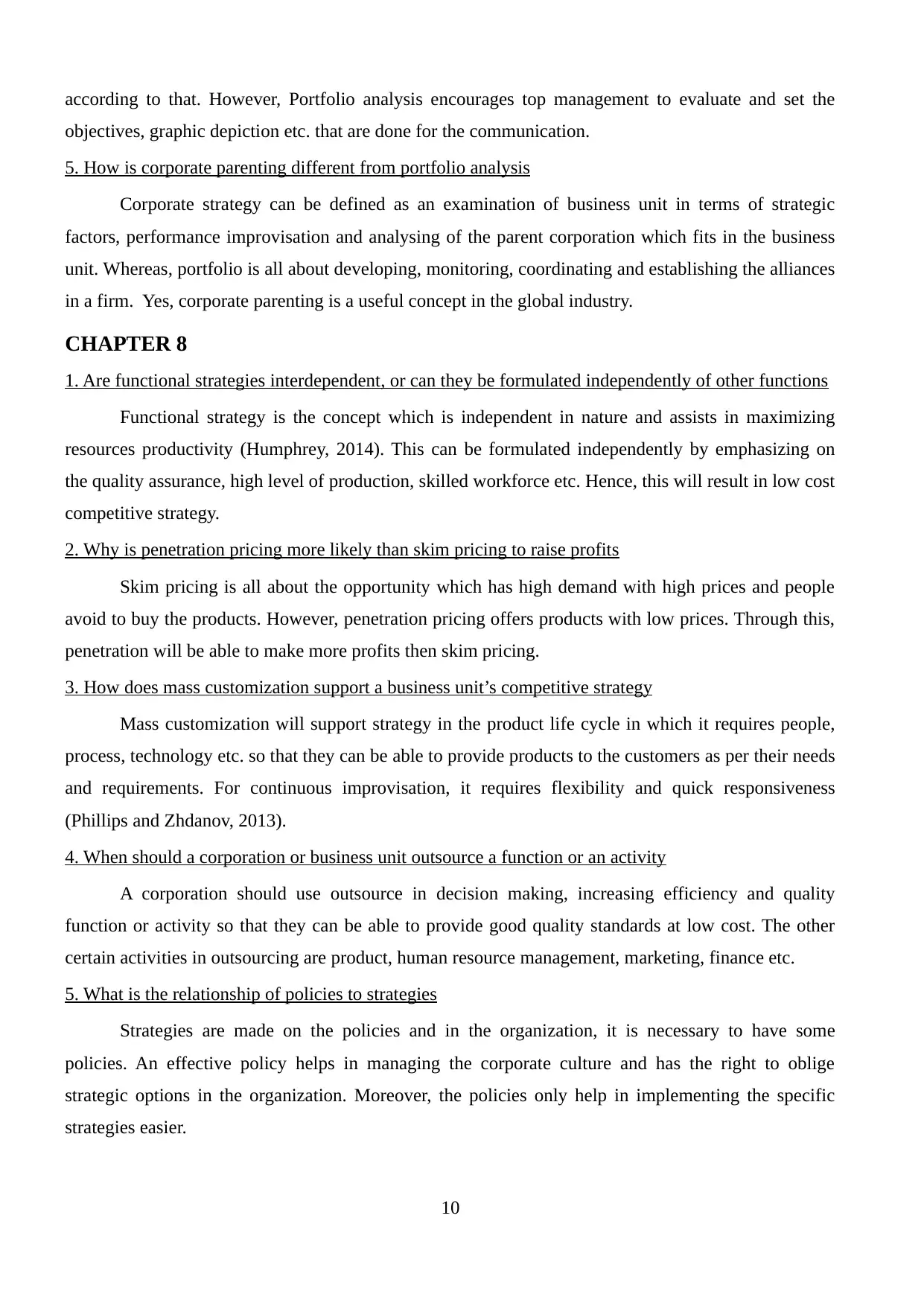
according to that. However, Portfolio analysis encourages top management to evaluate and set the
objectives, graphic depiction etc. that are done for the communication.
5. How is corporate parenting different from portfolio analysis
Corporate strategy can be defined as an examination of business unit in terms of strategic
factors, performance improvisation and analysing of the parent corporation which fits in the business
unit. Whereas, portfolio is all about developing, monitoring, coordinating and establishing the alliances
in a firm. Yes, corporate parenting is a useful concept in the global industry.
CHAPTER 8
1. Are functional strategies interdependent, or can they be formulated independently of other functions
Functional strategy is the concept which is independent in nature and assists in maximizing
resources productivity (Humphrey, 2014). This can be formulated independently by emphasizing on
the quality assurance, high level of production, skilled workforce etc. Hence, this will result in low cost
competitive strategy.
2. Why is penetration pricing more likely than skim pricing to raise profits
Skim pricing is all about the opportunity which has high demand with high prices and people
avoid to buy the products. However, penetration pricing offers products with low prices. Through this,
penetration will be able to make more profits then skim pricing.
3. How does mass customization support a business unit’s competitive strategy
Mass customization will support strategy in the product life cycle in which it requires people,
process, technology etc. so that they can be able to provide products to the customers as per their needs
and requirements. For continuous improvisation, it requires flexibility and quick responsiveness
(Phillips and Zhdanov, 2013).
4. When should a corporation or business unit outsource a function or an activity
A corporation should use outsource in decision making, increasing efficiency and quality
function or activity so that they can be able to provide good quality standards at low cost. The other
certain activities in outsourcing are product, human resource management, marketing, finance etc.
5. What is the relationship of policies to strategies
Strategies are made on the policies and in the organization, it is necessary to have some
policies. An effective policy helps in managing the corporate culture and has the right to oblige
strategic options in the organization. Moreover, the policies only help in implementing the specific
strategies easier.
10
objectives, graphic depiction etc. that are done for the communication.
5. How is corporate parenting different from portfolio analysis
Corporate strategy can be defined as an examination of business unit in terms of strategic
factors, performance improvisation and analysing of the parent corporation which fits in the business
unit. Whereas, portfolio is all about developing, monitoring, coordinating and establishing the alliances
in a firm. Yes, corporate parenting is a useful concept in the global industry.
CHAPTER 8
1. Are functional strategies interdependent, or can they be formulated independently of other functions
Functional strategy is the concept which is independent in nature and assists in maximizing
resources productivity (Humphrey, 2014). This can be formulated independently by emphasizing on
the quality assurance, high level of production, skilled workforce etc. Hence, this will result in low cost
competitive strategy.
2. Why is penetration pricing more likely than skim pricing to raise profits
Skim pricing is all about the opportunity which has high demand with high prices and people
avoid to buy the products. However, penetration pricing offers products with low prices. Through this,
penetration will be able to make more profits then skim pricing.
3. How does mass customization support a business unit’s competitive strategy
Mass customization will support strategy in the product life cycle in which it requires people,
process, technology etc. so that they can be able to provide products to the customers as per their needs
and requirements. For continuous improvisation, it requires flexibility and quick responsiveness
(Phillips and Zhdanov, 2013).
4. When should a corporation or business unit outsource a function or an activity
A corporation should use outsource in decision making, increasing efficiency and quality
function or activity so that they can be able to provide good quality standards at low cost. The other
certain activities in outsourcing are product, human resource management, marketing, finance etc.
5. What is the relationship of policies to strategies
Strategies are made on the policies and in the organization, it is necessary to have some
policies. An effective policy helps in managing the corporate culture and has the right to oblige
strategic options in the organization. Moreover, the policies only help in implementing the specific
strategies easier.
10
Paraphrase This Document
Need a fresh take? Get an instant paraphrase of this document with our AI Paraphraser
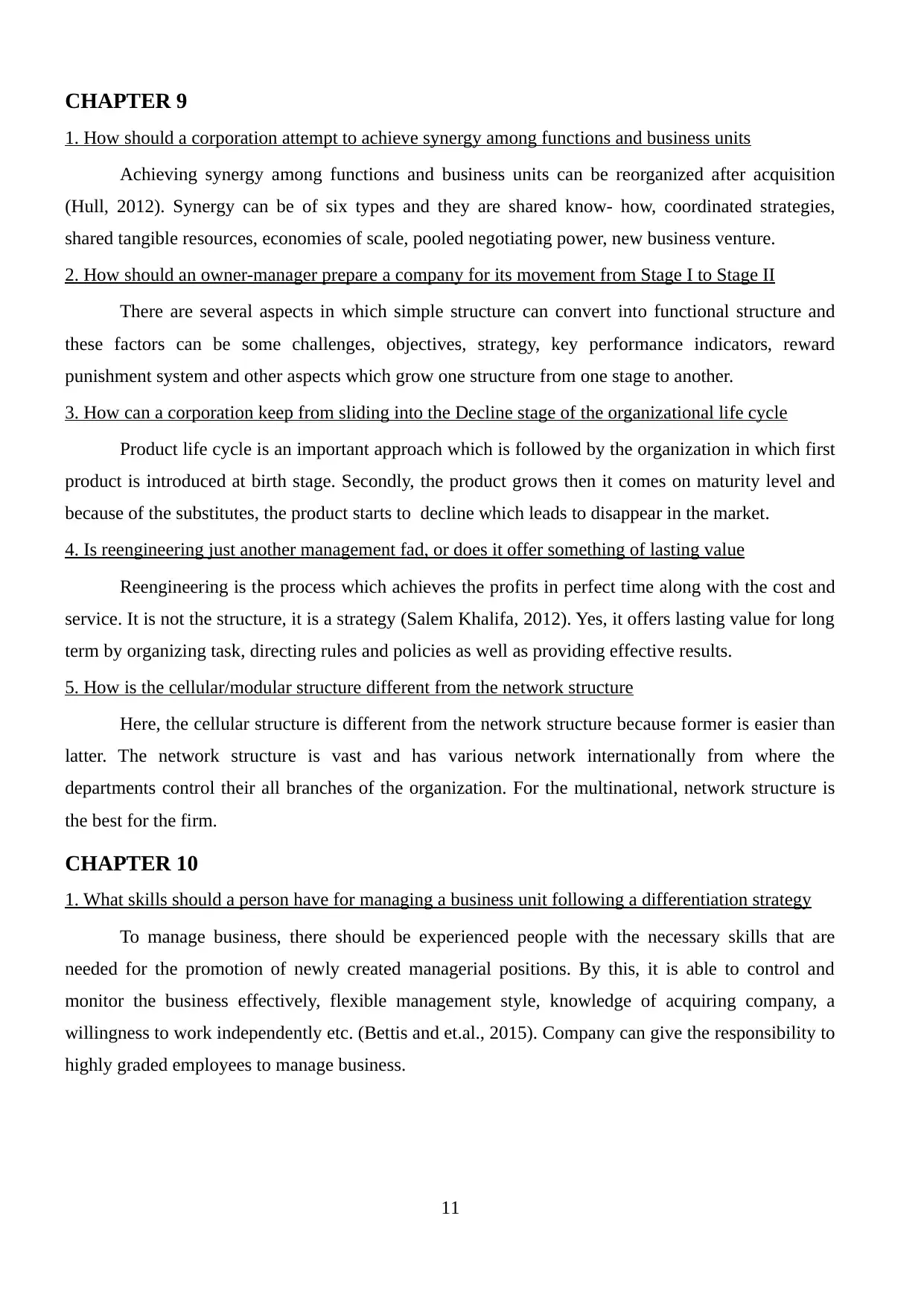
CHAPTER 9
1. How should a corporation attempt to achieve synergy among functions and business units
Achieving synergy among functions and business units can be reorganized after acquisition
(Hull, 2012). Synergy can be of six types and they are shared know- how, coordinated strategies,
shared tangible resources, economies of scale, pooled negotiating power, new business venture.
2. How should an owner-manager prepare a company for its movement from Stage I to Stage II
There are several aspects in which simple structure can convert into functional structure and
these factors can be some challenges, objectives, strategy, key performance indicators, reward
punishment system and other aspects which grow one structure from one stage to another.
3. How can a corporation keep from sliding into the Decline stage of the organizational life cycle
Product life cycle is an important approach which is followed by the organization in which first
product is introduced at birth stage. Secondly, the product grows then it comes on maturity level and
because of the substitutes, the product starts to decline which leads to disappear in the market.
4. Is reengineering just another management fad, or does it offer something of lasting value
Reengineering is the process which achieves the profits in perfect time along with the cost and
service. It is not the structure, it is a strategy (Salem Khalifa, 2012). Yes, it offers lasting value for long
term by organizing task, directing rules and policies as well as providing effective results.
5. How is the cellular/modular structure different from the network structure
Here, the cellular structure is different from the network structure because former is easier than
latter. The network structure is vast and has various network internationally from where the
departments control their all branches of the organization. For the multinational, network structure is
the best for the firm.
CHAPTER 10
1. What skills should a person have for managing a business unit following a differentiation strategy
To manage business, there should be experienced people with the necessary skills that are
needed for the promotion of newly created managerial positions. By this, it is able to control and
monitor the business effectively, flexible management style, knowledge of acquiring company, a
willingness to work independently etc. (Bettis and et.al., 2015). Company can give the responsibility to
highly graded employees to manage business.
11
1. How should a corporation attempt to achieve synergy among functions and business units
Achieving synergy among functions and business units can be reorganized after acquisition
(Hull, 2012). Synergy can be of six types and they are shared know- how, coordinated strategies,
shared tangible resources, economies of scale, pooled negotiating power, new business venture.
2. How should an owner-manager prepare a company for its movement from Stage I to Stage II
There are several aspects in which simple structure can convert into functional structure and
these factors can be some challenges, objectives, strategy, key performance indicators, reward
punishment system and other aspects which grow one structure from one stage to another.
3. How can a corporation keep from sliding into the Decline stage of the organizational life cycle
Product life cycle is an important approach which is followed by the organization in which first
product is introduced at birth stage. Secondly, the product grows then it comes on maturity level and
because of the substitutes, the product starts to decline which leads to disappear in the market.
4. Is reengineering just another management fad, or does it offer something of lasting value
Reengineering is the process which achieves the profits in perfect time along with the cost and
service. It is not the structure, it is a strategy (Salem Khalifa, 2012). Yes, it offers lasting value for long
term by organizing task, directing rules and policies as well as providing effective results.
5. How is the cellular/modular structure different from the network structure
Here, the cellular structure is different from the network structure because former is easier than
latter. The network structure is vast and has various network internationally from where the
departments control their all branches of the organization. For the multinational, network structure is
the best for the firm.
CHAPTER 10
1. What skills should a person have for managing a business unit following a differentiation strategy
To manage business, there should be experienced people with the necessary skills that are
needed for the promotion of newly created managerial positions. By this, it is able to control and
monitor the business effectively, flexible management style, knowledge of acquiring company, a
willingness to work independently etc. (Bettis and et.al., 2015). Company can give the responsibility to
highly graded employees to manage business.
11
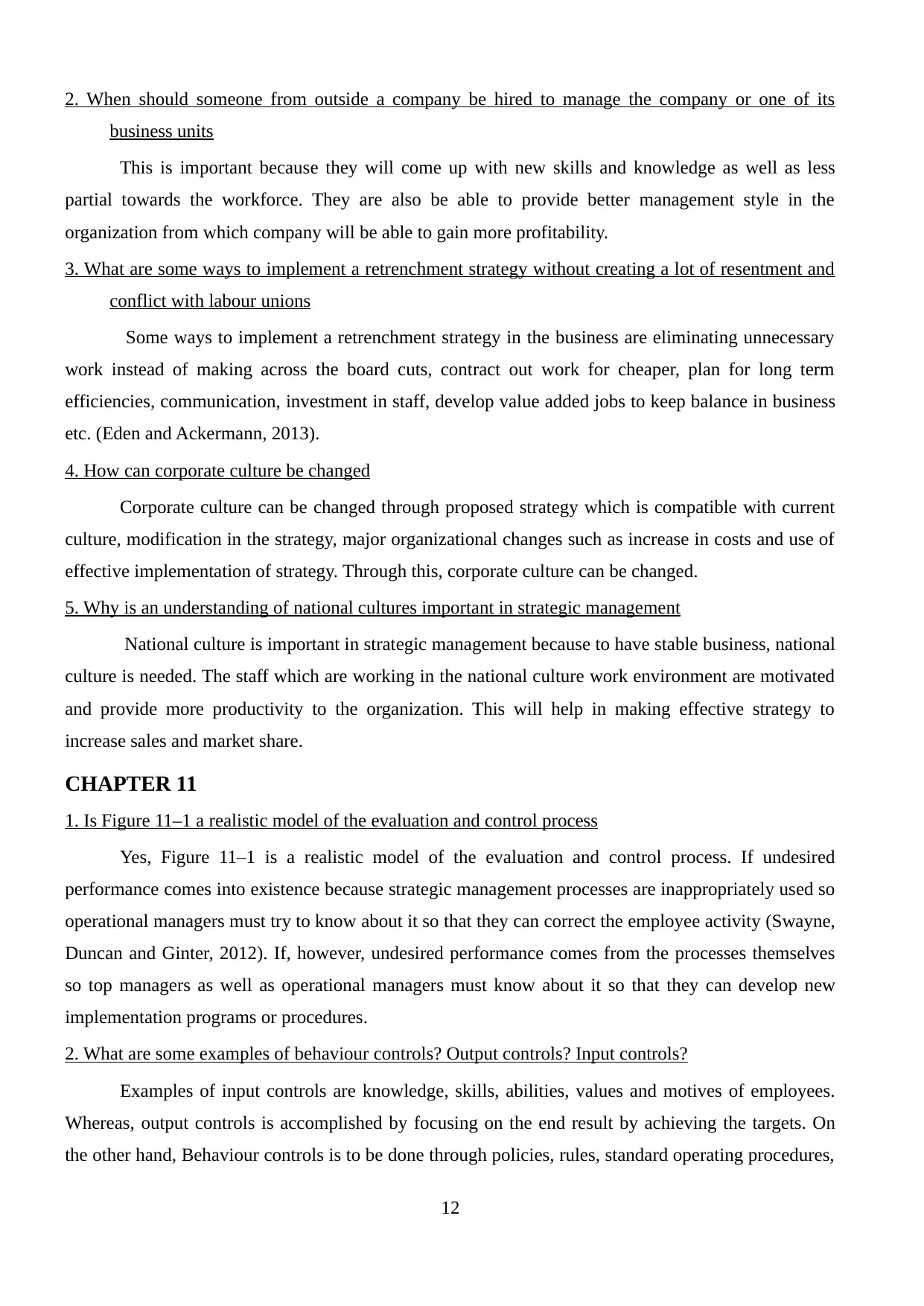
2. When should someone from outside a company be hired to manage the company or one of its
business units
This is important because they will come up with new skills and knowledge as well as less
partial towards the workforce. They are also be able to provide better management style in the
organization from which company will be able to gain more profitability.
3. What are some ways to implement a retrenchment strategy without creating a lot of resentment and
conflict with labour unions
Some ways to implement a retrenchment strategy in the business are eliminating unnecessary
work instead of making across the board cuts, contract out work for cheaper, plan for long term
efficiencies, communication, investment in staff, develop value added jobs to keep balance in business
etc. (Eden and Ackermann, 2013).
4. How can corporate culture be changed
Corporate culture can be changed through proposed strategy which is compatible with current
culture, modification in the strategy, major organizational changes such as increase in costs and use of
effective implementation of strategy. Through this, corporate culture can be changed.
5. Why is an understanding of national cultures important in strategic management
National culture is important in strategic management because to have stable business, national
culture is needed. The staff which are working in the national culture work environment are motivated
and provide more productivity to the organization. This will help in making effective strategy to
increase sales and market share.
CHAPTER 11
1. Is Figure 11–1 a realistic model of the evaluation and control process
Yes, Figure 11–1 is a realistic model of the evaluation and control process. If undesired
performance comes into existence because strategic management processes are inappropriately used so
operational managers must try to know about it so that they can correct the employee activity (Swayne,
Duncan and Ginter, 2012). If, however, undesired performance comes from the processes themselves
so top managers as well as operational managers must know about it so that they can develop new
implementation programs or procedures.
2. What are some examples of behaviour controls? Output controls? Input controls?
Examples of input controls are knowledge, skills, abilities, values and motives of employees.
Whereas, output controls is accomplished by focusing on the end result by achieving the targets. On
the other hand, Behaviour controls is to be done through policies, rules, standard operating procedures,
12
business units
This is important because they will come up with new skills and knowledge as well as less
partial towards the workforce. They are also be able to provide better management style in the
organization from which company will be able to gain more profitability.
3. What are some ways to implement a retrenchment strategy without creating a lot of resentment and
conflict with labour unions
Some ways to implement a retrenchment strategy in the business are eliminating unnecessary
work instead of making across the board cuts, contract out work for cheaper, plan for long term
efficiencies, communication, investment in staff, develop value added jobs to keep balance in business
etc. (Eden and Ackermann, 2013).
4. How can corporate culture be changed
Corporate culture can be changed through proposed strategy which is compatible with current
culture, modification in the strategy, major organizational changes such as increase in costs and use of
effective implementation of strategy. Through this, corporate culture can be changed.
5. Why is an understanding of national cultures important in strategic management
National culture is important in strategic management because to have stable business, national
culture is needed. The staff which are working in the national culture work environment are motivated
and provide more productivity to the organization. This will help in making effective strategy to
increase sales and market share.
CHAPTER 11
1. Is Figure 11–1 a realistic model of the evaluation and control process
Yes, Figure 11–1 is a realistic model of the evaluation and control process. If undesired
performance comes into existence because strategic management processes are inappropriately used so
operational managers must try to know about it so that they can correct the employee activity (Swayne,
Duncan and Ginter, 2012). If, however, undesired performance comes from the processes themselves
so top managers as well as operational managers must know about it so that they can develop new
implementation programs or procedures.
2. What are some examples of behaviour controls? Output controls? Input controls?
Examples of input controls are knowledge, skills, abilities, values and motives of employees.
Whereas, output controls is accomplished by focusing on the end result by achieving the targets. On
the other hand, Behaviour controls is to be done through policies, rules, standard operating procedures,
12
⊘ This is a preview!⊘
Do you want full access?
Subscribe today to unlock all pages.

Trusted by 1+ million students worldwide
1 out of 16
Related Documents
Your All-in-One AI-Powered Toolkit for Academic Success.
+13062052269
info@desklib.com
Available 24*7 on WhatsApp / Email
![[object Object]](/_next/static/media/star-bottom.7253800d.svg)
Unlock your academic potential
Copyright © 2020–2025 A2Z Services. All Rights Reserved. Developed and managed by ZUCOL.



